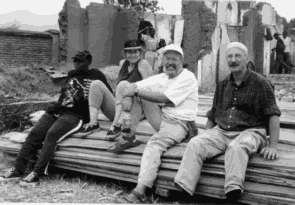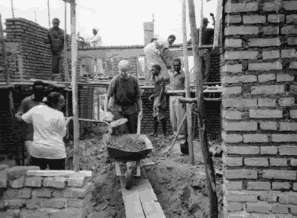|
PO Box 10372 |

|
 |
|
|
|
FALL, 1999: Volume 4 Issue 3
A Forgotten
Land by Adrian Bishop, Team Co-coordinator
��This is a forgotten land.� These
words were spoken to me by my friend Dieudonne in Gitega, Burundi,�this
past August. We were talking at the end of another long day of working�at
reconstruction and reconciliation in his country. We had just learned
of��rebel� attacks and military reprisals that had killed at least 100
people,�mostly unarmed civilians. The news took the edge off the euphoria
we�experienced earlier in the day when young soldiers joined our conflict�resolution
training workshop at Kibimba School. We also both felt that it�was unlikely
that anyone outside Burundi would notice. For 30
days, in this last summer before the millennium, I lived and worked�with
Elie Nahimana, Johnny Johnson MD, Alexia Nibona, Zainabu Dance,�Benigne
Irakoze, Becky Calcraft, Gentil Ntibagirirwa, Ray Boucher, Charles�Berahino,
Bette Hoover, Terrance Mkumimana, Josette Ngemdakumana, Joy�Zarembka,
and Thadee Nizirizana. We were the international team of�volunteers
who staffed the Kamenge Reconstruction and Reconciliation�Project sponsored
by Burundi Yearly Meeting and the African Great Lakes�Initiative (AGLI)
of Friends Peace Teams Project (FPTP). Our team, with�individuals ranging
from age 20 to 59, brought with us a diversity of life�experience, beliefs,
and racial and national origins. The broad goals of the�Kamenge Project
were to engage in conflict resolution training and workshops�and to
rebuild the residence and guest house at Kamenge Friends Church�destroyed
in 1995 during the �crisis,� the name used to describe the�massacres
and pillage which began in 1993. Diary Entry of Joy Zarembka With the multifaceted skills of the team, we also videotaped and documented�the stories of Burundians and the work of peacemakers. We engaged in other�supportive activities as way opened. We also hope that we laid the basis for�future projects. At the beginning of the Project, we had two days of�teambuilding orientation which included recording statements of�expectations from the team members. At our final meeting, we felt that we�had made progress on nearly all the stated expectations. By the end, I was�pleased with what we accomplished, and hope that our experiences and�recommendations to AGLI will make for even more productive ventures in the�future. After several weeks, I found myself in an almost constant state of sensory�and spiritual overload. Burundi is intensely beautiful�deep lush valleys,�terraced mountainsides, running rivers, huge lakes that are home to�hippopotamuses and crocodiles. The headwaters of the Nile and Zambezi�drainage basins are both in Burundi. Yet, this is one of the poorest nations�in the world. The soil is sadly depleted and the civil war has caused the�death of hundreds of thousands of people in the last two decades. For me,�the most poignant moment of our work together was discovering human bones�still unburied. People had been too afraid of being killed to bury them. In the
Kamenge area of the capital, Bujumbura, we rebuilt the pastor�s�residence
and guest house. Each day we were joined by forty students and six to
twelve �fundis� (builders). We built the structure entirely by hand
with bricks�made from clay taken from the edge of the steam at the site
and baked there�in kilns. At the end of the month the building was about
90% complete and�habitable, and materials were on order to complete
it. This is the first�structure to be rebuilt in this part of Kamenge
since the suburb was largely�destroyed and then abandoned after episodes
of slaughtering and looting in�the last 6 years. It will house Friends
visiting Kamenge and�Burjumbura, as well as secure the church ground
from further vandalism, and�will house other community programs until
other facilities are built.
We conducted Conflict Resolution and Training workshops in Kamenge and�upcountry in Gitega region. In Gitega, we were blessed to be able to work�with Mi-PAREC (Ministry for Peace and Reconciliation Under the Cross) a�local interdenominational peace training organization initiated with the�help of the Mennonite Central Committee (MCC) and the Burundi Yearly�Meeting. Mi-PAREC offers training in conflict resolution particularly for�community leaders, and is gradually building a network of local peace�committees in the provinces of Burundi (and starting soon in Rwanda). They�are very deliberate at every opportunity to engage members of the military�in dialogue. It was while working with Mi-PAREC at Kibimba School that we�were joined by local soldiers who took an active part in the peacemaking�exercises and discussions. We recorded miles of videotaped interviews of Burundians who have survived the�atrocities. This is no small matter. Many had miraculous escapes, all have�had relatives and friends killed, and many are still refugees or displaced�persons. We are hoping to secure the necessary funds to edit the interviews�into a format to tell the world about the plight of Burundi. Most of
the team spent a week in a workcamp of about 400 participants at�Kibimba,
the site of the first Friends Church, where we took part in�preparing
the Kibimba Secondary School to re-open. The doctor on our team�was
able to contribute significantly at the Dispensary, where he worked
with�the medical team and introduced some of our student team members
to medicine�in action. In September, this hospital is expecting to welcome
its first�staff doctor in six years. The secondary school (which was
started by�Friends but which had been a state school since the 1980�s)
and the Friends�Church which shares the secondary school compound, had
been appropriated as�a refugee center and military barracks during the
crisis. Up until very�recently, the military had planned to develop
the site as a permanent�barracks but the Yearly Meeting and the local
Peace Committee argued�successfully against this transition. A Cabinet
member supported their�wishes, and an agreement is now in place whereby
Friends will re-open the�school, with the Burundi government paying
the teachers� salaries. Peace�Studies is to be part of the curriculum.
On our last Sunday in Kibimba,�about 2000 Friends gathered to rededicate
their restored church!
A huge bonus for our team was participating in a consultation sponsored by�MCC on Conscientious Objection in the Great Lakes Region. Participants were�Quakers and Mennonites from Congo, Rwanda and Burundi, as well as from�Guatemala and Columbia. It was remarkable for us all to realize the ghastly�similarities in the conflicts that have plagued both the Great Lakes Region�and Latin America. There were many frank exchanges that led to a statement�of commitment regarding conscientious objection in the region and to a�second consultation in March, 2000. There was a real struggle to seek common�ground away from nationalistic positions. This is very hard to do when,�despite similarities of belief, there are soldiers from the other person�s�country fighting in your country, even as you are meeting together. For the long term, we return with a profound awareness of the horrors that�humans are capable of inflicting on one another, and with appreciation of�the commitment of Burundi Yearly Meeting to work for peace. I hope that�Friends will be supportive of FPTP and AGLI as we prepare to collaborate�with Burundi Yearly Meeting in activating a long term Peace Team in Burundi.�The Team will focus particularly on training Burundians to be facilitators�in conflict resolution and trauma healing. For related earlier articles see:
TOP
• CURRENT Issue Index • PTN
Index • HOME |
||

